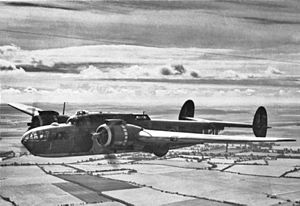Armstrong Whitworth Albemarle
| Albemarle | |
|---|---|
 |
|
| Armstrong Whitworth Albemarle Mark I series 2 (P1475) of 511 Squadron c. 1942 | |
| Role | Transport, glider tug |
| Manufacturer | A W Hawksley Ltd |
| Designer | Armstrong Whitworth Aircraft |
| First flight | 20 March 1940 |
| Primary user | RAF |
| Produced | 1941–1945 |
| Number built | 602 |
The Armstrong Whitworth A.W.41 Albemarle was a British twin-engine transport aircraft that entered service during the Second World War.
The Albemarle was originally designed as a medium bomber, but never served in that role, instead being used for general and special transport duties, paratroop transport and glider towing, including significant actions such as Normandy and the assault on Arnhem during Operation Market Garden.
Air Ministry Specification B.9/38 required a twin-engine medium bomber of wood and metal construction, that could be built by manufacturers outside the aircraft industry, and without using light alloys. The Air Ministry was concerned that if there was a war, the restricted supply of materials might affect construction of bombers.
Armstrong Whitworth, Bristol and de Havilland were approached for designs. Bristol proposed two designs - a conventional 80 ft wingspan capable of 300 mph, and a tricycle design with 70 ft span with a maximum speed of 320 mph. Both designs, known as the Type 155, used two Bristol Hercules engines. Armstrong Whitworth's AW.41 design used a tricycle undercarriage and was built up of sub-sections to ease manufacture by firms without aircraft construction experience. The AW.41 was designed with Rolls-Royce Merlin engines in mind, but with Bristol Hercules as an alternative ("shadow") engine.
In June 1938, mockups of both the AW.41 and Bristol 155 were examined, and new specifications B.17/38 and B.18/38 were drawn up for the respective designs. De Havilland did not submit a design. The specification stipulated 250 miles per hour (400 km/h) at 15,000 feet (4,600 m) economical cruise while carrying 4,000 lb (1,800 kg) of bombs. However, Bristol was already heavily engaged with other aircraft production and development, and stopped work on the 155.
...
Wikipedia
